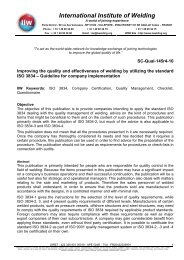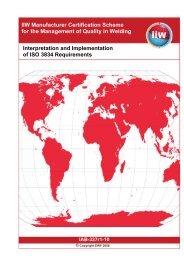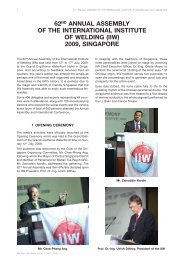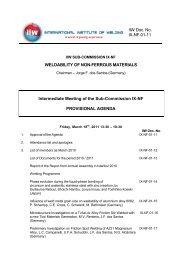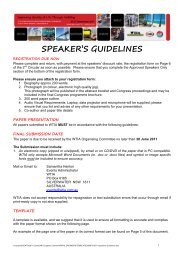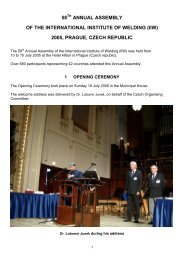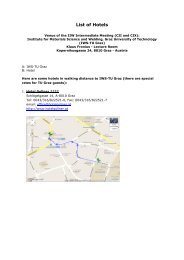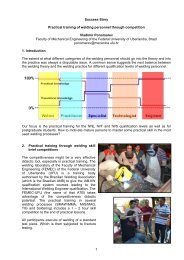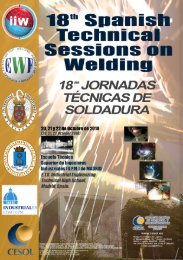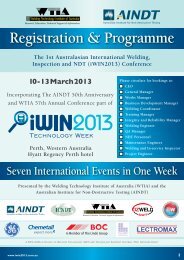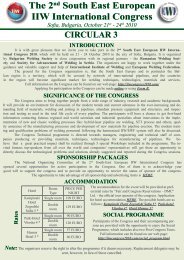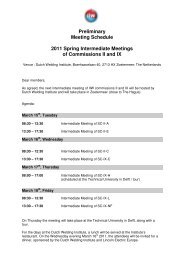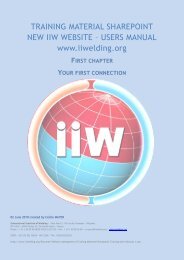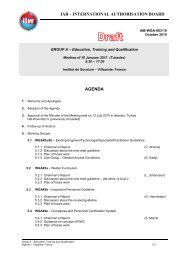2010 - IIW
2010 - IIW
2010 - IIW
You also want an ePaper? Increase the reach of your titles
YUMPU automatically turns print PDFs into web optimized ePapers that Google loves.
Assessment for Postulated or Real Flaw<br />
Material & Weld related<br />
input parameters:<br />
Component related<br />
input parameters:<br />
• Tensile data, Fracture<br />
W<br />
•Flaw size, Stress analysis,<br />
a<br />
FITNET FFS ANALYSIS for WELDS<br />
Mis-match ratio<br />
M=YS WM /YS BM<br />
Prediction of critical condition<br />
• Flaw Size<br />
• Stress Level<br />
• Material Property<br />
Figure 24. Flow chart of the Fracture Module of the FITNET FFS Procedure for assessment of the weld flaw.<br />
Defects in welded structures often occur within or<br />
near welds across which tensile properties<br />
significantly vary. As described in previous sections,<br />
this strength mis-match in tensile properties can<br />
affect the plastic deformation pattern of the defective<br />
component, and thus the crack driving force such as<br />
CTOD or J integral. Until research work was<br />
conducted within European project SINTAP [18, 37],<br />
existing defect assessment methods were restricted to<br />
the homogeneous structures. In principle, the<br />
methods for homogenous structures can be applied to<br />
welded structures, if the tensile properties of the<br />
weakest material are used; for instance, for<br />
overmatched welds (M>1), those of the base metal.<br />
However, such a simplified approach can lead to an<br />
unduly conservative result, and thus a FFS<br />
methodology specific to strength mismatched<br />
structures was needed to reduce excessive<br />
conservatism. For this very reason, the SINTAP<br />
Procedure [14, 18, 25, 37] introduced a novel flaw<br />
assessment route for strength mis-match welds.<br />
FITNET FFS Procedure [34, 35] takes over these<br />
routes (Options 2 and 3), Figure 18, for treatment of<br />
conventional multi-pass and advanced (laser and<br />
friction stir) welded structures [25, 31, 32]. The latter<br />
one particularly exhibits significant (up to 50%)<br />
strength undermatching in structural welds used in<br />
aluminium structures of automobile, marine and<br />
aerospace. Figure 20 illustrates the principle of the<br />
FITNET FFS procedure for weldments.<br />
4.2 Mis-match Limit Load<br />
The limit load of the welded structure is the most<br />
crucial parameter for the assessment of the strength<br />
mis-matched welded structures. The limit load of<br />
mis-matched structures differs from those of<br />
homogeneous all base metal or all weld metal<br />
structures or considerations. It lies between these two<br />
limits and controls the evolution of plastic<br />
deformation of the cracked body and hence of the<br />
crack driving force. In classical solid mechanics the<br />
limit load is defined as the maximum load a<br />
component of elastic-ideally plastic material is able<br />
to withstand, above this limit ligament yielding<br />
becomes unlimited. In contrast to this definition, real<br />
materials strain harden with the consequence that the<br />
applied load may increase beyond the value given by<br />
the non-hardening limit load. Sometimes strain<br />
hardening is roughly taken into account by replacing<br />
the yield strength of the material by an equivalent<br />
yield strength (flow strength) in the limit load<br />
equation. In the fitness-for-service (FFS) analysis<br />
procedure FITNET, numbers of limit load solutions,<br />
including newly developed [e.g 13, 15,] are given<br />
in Annex B (Vol II) [35]. The results and recent<br />
developments of SINTAP, BS7910, R6 sources are<br />
used to generate this Annex.<br />
Extensive validation works have been conducted<br />
during the development of the FITNET FFS<br />
Procedure. Some of these investigations can be found<br />
in [21-33]. Furthermore, series of collected case



